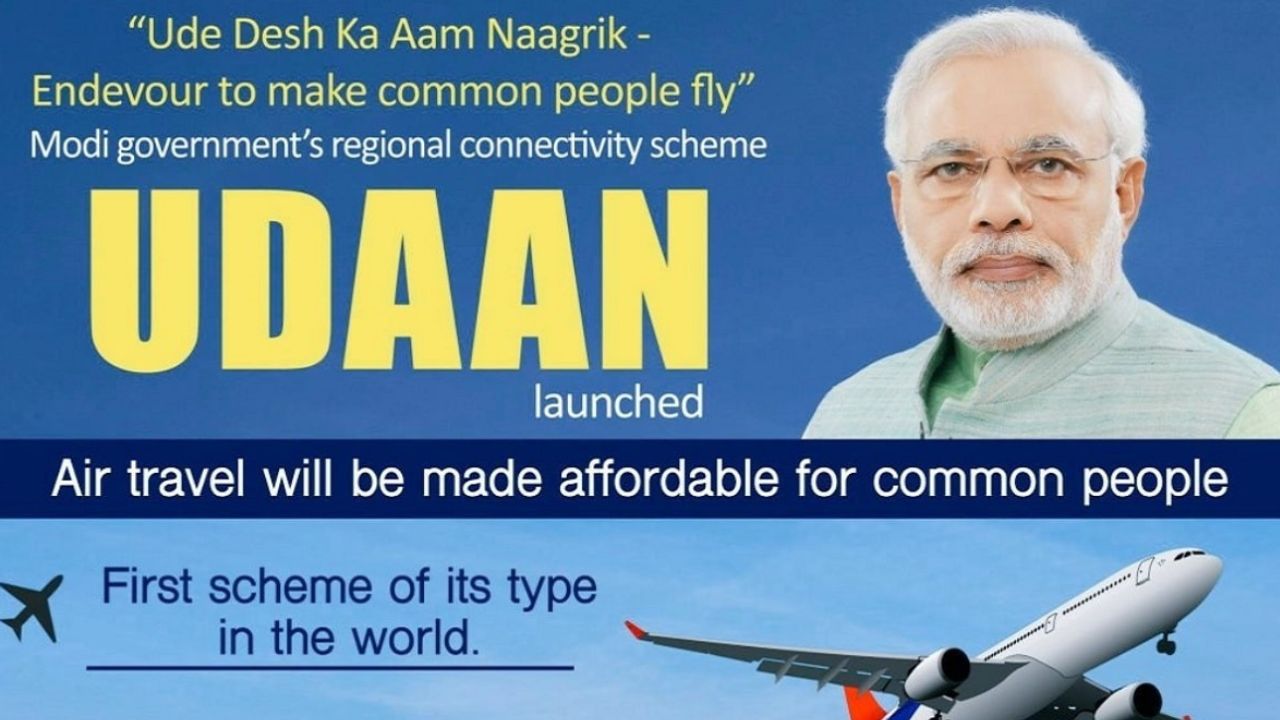For decades, flying in India was seen as a luxury, a privilege reserved for the wealthy and a service connecting only the major metro cities. Hundreds of smaller towns had airstrips, but they lay dormant and unused. The dream of air travel for the common person seemed distant.
This entire paradigm was challenged with the launch of the UDAN Scheme in 2017. UDAN, which stands for Ude Desh ka Aam Nagrik (Let the Common Citizen of the Country Fly), is a revolutionary government initiative with a powerful vision: to make air travel accessible and affordable for the masses and to connect the vast, untapped potential of India’s regional towns. It’s built on the dream that even a person wearing hawai chappals (slippers) should be able to fly.
What is the UDAN Scheme? The Big Idea
- Full Name: Ude Desh ka Aam Nagrik (UDAN)
- Launched: 2017
- Ministry: Ministry of Civil Aviation
- The Dual Goal: The scheme has two clear and interconnected objectives:
- Boost Regional Connectivity: To operationalize the dozens of unserved and underserved airports in Tier-2 and Tier-3 cities, effectively putting them on the national aviation map.
- Make Flying Affordable: To ensure that the flights on these new regional routes are affordable for the common person.
How Does UDAN Work? The Smart Mechanism
The scheme’s success lies in its innovative and financially smart model.
Viability Gap Funding (VGF)
Let’s be honest, running flights to small towns with low initial demand isn’t always profitable for airlines. To solve this, the government provides a financial subsidy to the airline, known as Viability Gap Funding (VGF). This funding “bridges the gap” between the cost of running the flight and the revenue earned from the capped fares, making the route financially viable for the airline to operate.
Capping the Airfares
Here’s the part that benefits the passenger directly. In exchange for the VGF subsidy, airlines must agree to cap the airfare for at least 50% of the seats on a UDAN flight. The famous price cap that launched the scheme was ₹2,500 for a one-hour flight (covering a distance of about 500-600 km). This single measure brought air travel within the reach of millions.
The Regional Connectivity Fund (RCF)
So, where does the money for the VGF subsidy come from? It’s generated from a Regional Connectivity Fund (RCF). This fund is created by levying a very small fee on flights operating on major, profitable routes (like Delhi-Mumbai). In essence, passengers on trunk routes cross-subsidize the flights that connect smaller towns, making it a self-sustaining model.
Competitive Bidding for Routes
The government doesn’t just hand out routes. It invites airlines to bid for the routes they wish to operate under the scheme. The airline that asks for the lowest VGF subsidy is typically awarded the route. This competitive process ensures that the government’s subsidy is used efficiently.
The Human Touch: A Town Takes Flight
For years, Ajay, a textile merchant from Kishangarh in Rajasthan, found it incredibly difficult to expand his business. The nearest major airport was in Jaipur, a tiring 3-hour drive away. To meet clients in big cities like Mumbai or Surat, he would lose almost a full day just in travel.
Then, Kishangarh’s small airport was revived under the UDAN scheme. Suddenly, there were direct flights to major commercial hubs. Ajay booked his first flight to Surat for about ₹2,200, a journey that took just over an hour. This was a complete game-changer. He could now visit his suppliers in the morning and be back home by evening. His business grew, and he was able to create more jobs in his town. The UDAN flight didn’t just save him time; it connected his small town’s economy to the rest of the nation.
Impact and Challenges
The UDAN scheme has been widely hailed as a success story in Indian aviation.
Impact
- Massive Network Expansion: As of mid-2025, the scheme has successfully operationalized over 550 new routes and connected more than 80 previously unserved or underserved airports, including heliports and water aerodromes.
- Democratizing Air Travel: Over 1.5 crore passengers have availed the benefits of affordable flying on UDAN flights.
- Economic Boost: The scheme has been a major catalyst for tourism, trade, and economic development in the smaller towns that are now connected by air.
Challenges
- Sustainability of Routes: The biggest challenge is ensuring that these regional routes remain commercially viable for airlines even after the government’s VGF subsidy (which is provided for 3 years) ends.
- Infrastructure Hurdles: Many of the smaller airports still lack robust infrastructure like night landing facilities, which limits the number of flights they can handle.
- Operational Issues: There is a shortage of the smaller aircraft required for these routes, as well as a shortage of trained pilots and maintenance crew, which can sometimes disrupt services.
Conclusion
The UDAN scheme is a game-changing initiative that has truly redrawn the aviation map of India. It has successfully unlocked the potential of regional air travel, moving it from a luxury good to a more accessible service for the common citizen. By connecting the heartlands of India, UDAN is doing more than just helping people fly; it’s boosting local economies, promoting tourism, creating jobs, and weaving the nation closer together. It is a powerful engine for inclusive growth, taking India’s development story to its smaller towns and cities.
